Nutfiyeva Dildora 1

DOI: https://doi.org/10.5281/zenodo.15189067
Zenodo community: https://zenodo.org/records/15189067
Nordic_press journal: https://research.nordicuniversity.org/index.php/nordic/article/view/2304
MAQOLANI YUKLAB OLISH
SERTIFIKATNI YUKLAB OLISH
REVIEW:
Nutfiyeva Dildora's article presents an insightful examination of how innovative foreign language teaching methods can contribute to enhancing inclusive education in higher education institutions. The author argues that with the increasing diversity in student populations—be it due to varying cognitive, physical, or socio-economic backgrounds—the need for an inclusive and accessible educational environment has never been more critical. The article outlines how foreign language education, a pivotal part of higher education, can play an essential role in promoting inclusivity.
The article's primary strength lies in its comprehensive exploration of modern teaching methods that foster inclusivity. Nutfiyeva emphasizes the significance of adopting approaches like technology-assisted learning, Universal Design for Learning (UDL), gamification, and culturally responsive teaching. These strategies are crucial in addressing the various challenges posed by traditional one-size-fits-all approaches to language learning, which often fail to meet the diverse needs of students. For example, students with auditory impairments or those with dyslexia face specific challenges in traditional language instruction, but with the integration of assistive technologies like text-to-speech software and AI-powered learning platforms, these students can engage more effectively in the learning process.
A particularly compelling argument in the article is Nutfiyeva's discussion of Universal Design for Learning (UDL), a framework that ensures language instruction is flexible and adaptable to the needs of all students. UDL allows for multiple means of representation and expression, facilitating the inclusion of students with varied learning preferences. Moreover, the inclusion of gamification and interactive tools such as Duolingo, Quizlet, and Kahoot! are shown to significantly enhance engagement and motivation, offering an interactive and enjoyable way for students to develop language skills.
The section on collaborative learning and peer-assisted language practice is another highlight. By fostering interaction among students of different language proficiency levels, Nutfiyeva showcases how peer learning can encourage mutual support, increase confidence, and enhance the overall language learning experience. The inclusion of culturally responsive teaching further enriches the learning environment by ensuring that the foreign language curriculum is sensitive to students’ cultural backgrounds, promoting both inclusivity and global awareness.
Despite these advantages, the article also addresses the challenges in implementing such innovative approaches, including limited resources, resistance to change among traditional educators, and the need for ongoing professional development. These challenges are balanced with potential solutions, such as investing in teacher training, securing institutional support, and adopting flexible technology solutions that can be tailored to different educational settings.
In conclusion, Nutfiyeva's article makes a compelling case for the integration of innovative foreign language teaching strategies in higher education. By highlighting the importance of inclusivity in language learning and suggesting practical, research-backed approaches, the author provides valuable insights for educators and institutions looking to foster a more equitable, accessible, and engaging academic environment. The implementation of these methods promises not only to improve language acquisition but also to ensure that all students, regardless of their background or abilities, have the opportunity to succeed in a multicultural and multilingual world.



